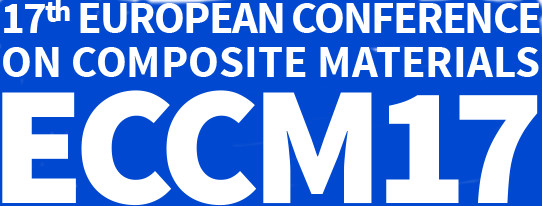

App-Einstellungen:
CHALLENGES FOR THERMOPLAST-AUTOMATED FIBER PLACEMENT (TP-AFP) WITH IN SITU CONSOLIDATION ON 3D PARTS
Andreas Kollmannsberger (Technical University of Munich) Elisabeth Ladstätter (Technical University of Munich / Institute for Carbon Composites) Klaus Drechsler (Technical University of Munich / Institute for Carbon Composites)
Based on an optimized 2D steady-state process this paper focuses on describing the differences for 3D lay-up on v-shaped tools with a rounded corner. Test specimens with different leg angles are manufactured and tested according to ASTM 6415.
CHARACTERISTICS AND PROCESSABILITY OF BINDERED DRY FIBRE MATERIAL FOR AUTOMATED FIBRE PLACEMENT
Laura Veldenz (National Composites Centre) Mattia Di Francesco (National Composites Centre) Simon Astwood (National Composites Centre) Giuseppe Dell'Anno (National Composites Centre) Byung Chul Kim (University of Bristol) Kevin Potter (University of Bristol)
A wide variety of dry fibre materials is available, the five examined materials show different behaviours in manufacturability. The use of the analytical hierarchy process enables a structured and purpose specific material selection.
IDENTIFICATION OF DEFECT IN THE AUTOMATED TAPE PLACEMENT PROCESS USING FIBRE BRAGG GRATING SENSORS
Ebrahim Oromiehie (UNSW Australia) B.Gangadhara Prusty (UNSW Australia) Paul Compston (Australian National University) Ginu Rajan (University of Wollongong)
In this paper, FBG sensors are implemented to identify defects during Automated Tape Placement lay-up process. Also, the capability of FBG sensor towards the measurement of acoustic emissions in a composite laminates is demonstrated experimentally.
DEVELOPMENT OF THE DIRECT ROVING PLACEMENT TECHNOLOGY (DRP)
Yannis Grohmann (German Aerospace Center) Niels Stoffers (German Aerospace Center) Alexandra Kühn (German Aerospace Center) Thorsten Mahrholz (German Aerospace Center)
Direct Roving Placement (DRP) is an upcoming low cost alternative to known Automated Fiber Placement (AFP) or Automated Tape Laying (ATL) processes. The main advantages of this technology are low material costs and high productivity.
DEVELOPMENT OF A HYBRID TAIL ROTOR DRIVE SHAFT BY THE USE OF THERMOPLASTIC AUTOMATED FIBER PLACEMENT
Stefan Ehard (Technical University of Munich / Institute for Carbon Composites) Elisabeth Ladstätter (Technical University of Munich / Institute for Carbon Composites) Michael Jürgens (Airbus Group Innovations) Laurent Bortolotto (Airbus Helicopters) Niklas Remer (Airbus Helicopters)
This work investigates the TP-AFP process for joining CF/PEEK and titanium substrates. Different surface pre-treatments are analysed on their impact on the joint strength. Based on this a hybrid tail rotor drive shaft is manufactured and tested.
EFFECT OF PROCESS PARAMETERS ON THE QUALITY OF LAMINATES MADE BY AUTOMATED FIBER PLACEMENT (AFP) USING OUT-OF-AUTOCLAVE (OOA) PREPREGS
Hongjie Sun (Concordia University) Déric Godin (Concordia University) Anqi Dong (Concordia University) Suong V. Hoa (Concordia University) Hasan Salek (Bombardier Aerostructures and Engineering Services)
This paper is the study on how different manufacturing parameters effect the quality, void content, in laminates made from out-of-autoclave (OOA) prepregs and using automated fiber placement (AFP).
EXPERIMENTAL ANALYSIS OF GAPS AND OVERLAPS CAUSED BY INTRA-PLY SECTORIZATION IN THE THERMOPLASTIC AUTOMATED FIBER PLACEMENT PROCESS
Thomas Zenker (Fraunhofer ICT) Christian Schuerger (Fraunhofer ICT)
Gap and overlap configurations were analyzed experimentally for the thermoplastic AFP-process in terms of preform surface homogeneity and influence on the layup of subsequent plies. Post-consolidation fiber angle distribution was investigated.
OPTICAL MODELLING OF VCSEL-ASSISTED THERMOPLASTIC TAPE PLACEMENT
Thomas Weiler (Aachen Center for integrative Lightweight Production) Michael Emonts (RWTH Aachen Univeristy) Stephan Gronenborn (Philips Photonics) Henning Janssen (Fraunhofer IPT)
A method for the calculation of the process intensity distribution in the nip zone area of VCSEL-assisted tape placement is presented and for two processing scenarios were analyzed: one for tape laying and one for tape winding.
LOWFLIP – AN INNOVATIVE DIRECT 3D PLACEMENT TECHNOLOGY FOR PLIES AND TAPES
Marko Szcesny (University of Stuttgart) Frieder Heieck (University of Stuttgart) Peter Middendorf (University of Stuttgart) Riccardo Mezzacasa (Fundacion TECNALIA Research and Deveopment) Xabier Irastorza (Fundacion TECNALIA Research and Deveopment) Harald Sehrschön (FILL GmbH) Michael Schneiderbauer (FILL GmbH)
A novel direct 3d placement method for plies and tapes developed within the LowFlip research project is presented. In addition data on a new out of autoclave prepeg with snap cure abilities and energy efficient tooling solutions are introduced.
MAXIMIZING THE OUT-OF-PLANE PERMEABILITY OF PREFORMS MANUFACTURED BY DRY FIBER PLACEMENT
Oliver Rimmel (Institute for Composite Materials) David Becker (Institute for Composite Materials) Jens Mack (Institute for Composite Materials) Peter Mitschang (Institute for Composite Materials)
Within this study influences on the out-of-plane permeability were investigated. The considered parameters were related to the material (e.g. binder amount) as well as the layup process and subsequent process steps.
